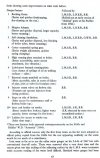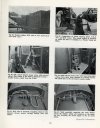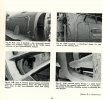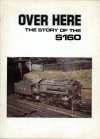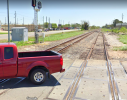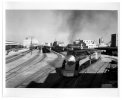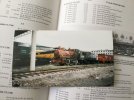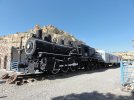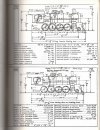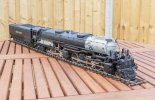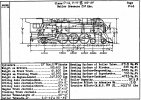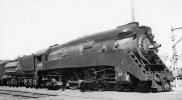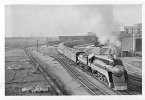Focalplane
Western Thunderer
EDIT: new thread title reflects ongoing subtle changes to concept brought about by research.
My parallel thread, Southern Pacific Remembered, has prompted me to bring out much of my HO stock and to think about what could be done with it without spending too much money and also to do it away from the Gauge O Railway Room in France. This is particularly so because of the Schengen 90/180 day rule means I have to leave France once the 90 day stay nears completion.
The photos I am collating of the SP, plus help from Google Street View in reminding me of certain places I last visited over 20 years ago, have given me an idea.
SP lines radiated in all directions from Houston and one I was particularly keen on was the north west line out to Hempstead and ultimately Dallas/Fort Worth. My office for many years was off the Hempstead Highway. This was before the building of US 290, to freeway standards. Hempstead Highway left Houston as Hempstead Road, quite close to the old MKT yard at Eureka. The multilevel Loop 610 was built over it and also the SP main line which paralleled the road for a considerable distance, offset on the southwestern side and serving numerous industry sidings. I can certainly remember short pickup dropdown freights with a GP switching mainly box cars. It would appear that today many of these sidings have gone, but this screen grab from Street View illustrates my idea better than the proverbial 1000 words.
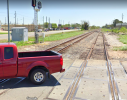
What the camera saw just 2 months ago includes a grade crossing (plenty of those in Houston) with the main line on the left and a loop siding on the right. It is this loop that provided the time and space for a pickup freight to operate. The various sidings would bear off down between low level warehouses and workshops. The streets in the area are generally on a NS/EW grid, so the NW-SE highway and SP main line required only a 45º turn from the loop. Unfortunately many of these sidings have been lifted but they are still shown on some satellite images, etc.
In addition to the pickup freight loop, there were also loops on the other side of the main line. In my days there, these loops could hold trains but were also used as storage for wagons holding plastic pellets until they were needed. Someone out there could help me by naming what these specialized wagons are called! I am more of a box car freak!
So, what plan could use all this information? Either a roundy round or a dumbell, I suppose, with passenger trains and fast fitted freights using the main line and secondary trains using the loops. Operations would be enhanced by switching box cars in and out of the sidings. But it could start just as a shunting plank, perhaps using a standard 6ft x 2ft module.
Ironically I only have main line steam locomotives at my disposal and only an SD-7 diesel would look at home on a pickup freight, so I need a steam switcher. The search is on! The other irony is that Texas never saw some of the illustrious California based 4-8-4s and 4-8-2s and Cab in Front articulateds were also confined to the Western Divisiions. So we may need a big Rule 1 here! The main line was used by two named trains, the Sunbeam and Owl, day and night trains to/from Dallas, but the motive power was limited to Pacifics (3 of which were streamline cased and painted in Daylight colours). Some imagination will be needed!
Here's an attempt at a satellite image captured:
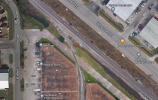
My parallel thread, Southern Pacific Remembered, has prompted me to bring out much of my HO stock and to think about what could be done with it without spending too much money and also to do it away from the Gauge O Railway Room in France. This is particularly so because of the Schengen 90/180 day rule means I have to leave France once the 90 day stay nears completion.
The photos I am collating of the SP, plus help from Google Street View in reminding me of certain places I last visited over 20 years ago, have given me an idea.
SP lines radiated in all directions from Houston and one I was particularly keen on was the north west line out to Hempstead and ultimately Dallas/Fort Worth. My office for many years was off the Hempstead Highway. This was before the building of US 290, to freeway standards. Hempstead Highway left Houston as Hempstead Road, quite close to the old MKT yard at Eureka. The multilevel Loop 610 was built over it and also the SP main line which paralleled the road for a considerable distance, offset on the southwestern side and serving numerous industry sidings. I can certainly remember short pickup dropdown freights with a GP switching mainly box cars. It would appear that today many of these sidings have gone, but this screen grab from Street View illustrates my idea better than the proverbial 1000 words.

What the camera saw just 2 months ago includes a grade crossing (plenty of those in Houston) with the main line on the left and a loop siding on the right. It is this loop that provided the time and space for a pickup freight to operate. The various sidings would bear off down between low level warehouses and workshops. The streets in the area are generally on a NS/EW grid, so the NW-SE highway and SP main line required only a 45º turn from the loop. Unfortunately many of these sidings have been lifted but they are still shown on some satellite images, etc.
In addition to the pickup freight loop, there were also loops on the other side of the main line. In my days there, these loops could hold trains but were also used as storage for wagons holding plastic pellets until they were needed. Someone out there could help me by naming what these specialized wagons are called! I am more of a box car freak!
So, what plan could use all this information? Either a roundy round or a dumbell, I suppose, with passenger trains and fast fitted freights using the main line and secondary trains using the loops. Operations would be enhanced by switching box cars in and out of the sidings. But it could start just as a shunting plank, perhaps using a standard 6ft x 2ft module.
Ironically I only have main line steam locomotives at my disposal and only an SD-7 diesel would look at home on a pickup freight, so I need a steam switcher. The search is on! The other irony is that Texas never saw some of the illustrious California based 4-8-4s and 4-8-2s and Cab in Front articulateds were also confined to the Western Divisiions. So we may need a big Rule 1 here! The main line was used by two named trains, the Sunbeam and Owl, day and night trains to/from Dallas, but the motive power was limited to Pacifics (3 of which were streamline cased and painted in Daylight colours). Some imagination will be needed!
Here's an attempt at a satellite image captured:

Last edited:





